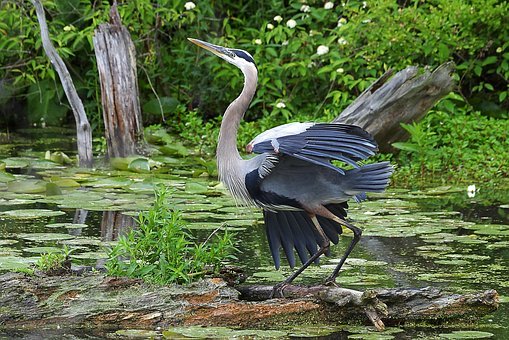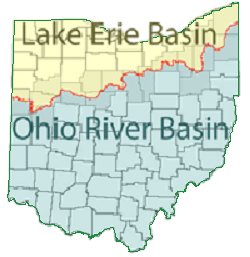Ohio Watersheds Are Crucial to
Its Sustainability
We all live in a watershed.
Residential areas, farms, forests, small towns, big cities …They’re all part of a massive watershed network. Watersheds cross municipal, county, state and even international borders.
They come in all shapes and sizes, encompassing millions of square miles or just a few acres. And like creeks that drain into rivers, small watersheds are almost always part of a larger watershed.
For instance, Ohio’s 23 major watersheds consist of 254 principal streams and rivers. But they all drain into either Lake Erie or the Ohio River. (See “Ohio’s Two Primary Watersheds,” below.)
Our landscape and all its activities interconnect with streams, lakes and rivers through their watersheds. Naturally varying lake levels, water movement to and from groundwater, and amount of stream flow influences them as well. The health of our waterways is largely determined by these dynamics between the land and the water.
Ohio’s Two Primary Watersheds
In Ohio, rivers north of the Continental Divide flow to Lake Erie and the St. Lawrence Seaway. Rivers south of the Divide flow to the Ohio River and, eventually, the Gulf of Mexico.
Learn more about the Lake Erie watershed:
Learn more about the Ohio River Watershed:
Becoming Watershed Wise
Watersheds must be protected if they are to sustain life. When human activities alter the natural function of the watershed, residents can be adversely affected by frequent flooding and routine periods of drought.
The three leading causes of polluted waterways are:
- Sediments
- Bacteria (such as E. coli), and
- Excess nutrients (such as nitrogen- and phosphate-based fertilizers).
Watershed-wise practices help create a balance and allow nature to work in our favor. When properly employed, residential landscapes can function as healthy mini-watersheds. The Green Gardens Group (G3) provides training and certification for its Watershed Approach to landscaping. This approach includes four key elements:
- Build Healthy Soil
- Capture Rainwater
- Select Native, Climate-Appropriate Plants
- Use Highly Efficient Irrigation
Smart irrigation technology (smart controllers, rain and soil-moisture sensors, and pressure regulators) is a key component of this approach and ensures optimal irrigation system performance.
Best Practices
As an irrigation and landscape professional, are you practicing watershed-wise principles, or are you contributing to the problem? Here are a few tips:
- Promote smart irrigation controllers and other technology with your customers, to ensure that runoff is reduced or even eliminated.

- Utilize matched precipitation rate (MPR) nozzles.
- Suggest that your customers create hydrozones (groups of plants with similar water needs) to conserve water.
- Offer your customers natural alternatives to nitrogen- or phosphate-based fertilizers? And suggest integrated pest management instead of pesticides.
- Make sure that roof runoff is directed onto a grassy area, not a sanitary or storm sewer system.
- Suggest porous surfaces for landscaping (such as flagstone, gravel or interlocking pavers), rather than impervious surfaces like concrete.
- Consider installing irrigation systems that draw from rainwater or gray water, whenever possible.
- Remind your customers that irrigation system management is critical! Systems must be actively and constantly managed in order to be watershed wise.
Take a Virtual Tour of
Ohio Watersheds
The Ohio Watershed Network offers a virtual tour of Ohio’s watersheds, beginning with the smallest streams in the watershed, the Headwaters.
From there, they move through the wider, slower-moving creeks and floodplains of the Middle Reaches. Then to the lakes, ponds and reservoirs, where sediments and many contaminants can collect.
The next stop is the precious Wetlands, with its large variety of plant and animal life. Finally, the last stop on the watershed tour is the Mighty River, where sediments, debris, or contaminants empty into the receiving waters.
We all affect the watershed, one way or another. Whether our individual influence is positive or negative is up to us.
Sources:
Featured Image: Pixabay
The Nature Conservancy
Green Gardens Group
WKYC
Ohio EPA











So many of Ohio’s landscapes exist on heavy clay soils. Run-off during irrigation is often a problem. Use two features most modern irrigation controllers provide to mitigate run-off;
1. Cycle-N-Soak
2. Weather based scheduling
Lets be part of the solution!